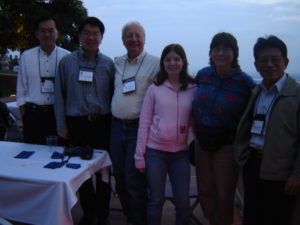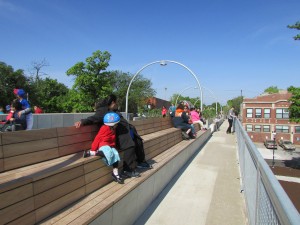“The cemeteries are full of indispensable people,” or variations thereof, is a quotation that has been attributed to many, including the late French President Charles de Gaulle, but according to Quote Investigator, actually belongs to an American writer Elbert Hubbard in 1907, using the phrase, “people the world cannot do without” and the word “graveyards.” But QI notes numerous sources over the years, many of which may well have borrowed from or built upon the other. The point is clear: None of us lives forever, and the world finds a way to move on without us. We can make an impact, but so can others. And we can come to terms with those facts long before we arrive at the cemetery.
Although it was not made public until January 9, I decided a few months ago that it was time to leave my post at the American Planning Association as manager of the Hazards Planning Center. There are two other such centers at APA—Green Communities, and Planning and Community Health—each of which has had at least three different managers since the National Centers for Planning were established in 2008 as a means of making clear APA’s commitment to certain leading-edge topics in planning. I have so far been the only manager for Hazards. More importantly, I built that center’s portfolio atop an existing legacy of work in the field of planning for hazards dating back to 1993, when I agreed to manage a project funded by the Federal Emergency Management Agency (FEMA) that led to publication of the landmark report, Planning for Post-Disaster Recovery and Reconstruction. I did not at first foresee the ways in which that effort would forever alter the arc of my career in urban planning. Looking back, there was nothing inevitable about it. While I was http://www.statenislandusa.com/heavily involved until then in environmental planning, almost none of it involved disasters. Once I sank my teeth deeply into the subject matter, however, there was no letting go. The Blues Brothers would have said that I was on a mission from God. Increasingly, I became aware of the high stakes for our society in properly planning our communities to cope with natural hazards.

One of the special pleasures of my position was the opportunity every summer to attend the Natural Hazards Conference in Colorado. Here, along with my wife, Jean, and daughter, Anna, in 2007, are some visitors from Taiwan whom I had met during a conference there the year before.
That quarter-century tenure in the driver’s seat of APA’s initiatives regarding disaster policy and practice made me, in some people’s minds at least, almost inseparable from the position I now hold. Perhaps in part because I was comfortable in working with the news media, I became the public face of APA in the realm of hazards planning. That may have been amplified to some extent by the fact that, until last year, the only APA employees working directly under me on a regular basis were interns, most of whom were graduate planning students. It’s not that I was a one-man show. I enlisted staff within the research department for specific projects with assigned hours. Given the expertise needed in this area, and my own willingness to listen to and learn from the best, most experienced people available, it was generally productive to contract with those people on a consulting basis or through partnerships with other organizations. Because APA is a professional organization with a membership of almost 40,000, those resources were readily available. I could marshal expertise far greater than any we could have hired for most of those years. Last year, however, we came to terms with growth and added research associate Joseph DeAngelis, who joined us after leaving the New York City Planning Department, where he had worked on Hurricane Sandy recovery on Staten Island. He has become a great asset to the organization.
His ability to span the transition to a new manager was one of several preconditions I had in mind over the last two or three years in contemplating my retirement from APA. More important, but a factor in adding him to our staff, was that I wanted to leave my successor with a center that was in good shape. This meant having projects underway, and funded by agreements with sponsors beyond the immediate few months after my departure. By late last year, we had won project grants from FEMA and the National Oceanic and Atmospheric Administration (NOAA) that will all end between July and December in 2018. That gives my successor, whoever he or she may be, more than adequate opportunity to complete those ongoing projects, maintain APA’s credibility in the realm of hazards, and explore new options and opportunities that will sustain the legacy that is already in place. I understand that people like me sometimes move quickly to another organization, firm, or government agency because a huge opportunity opens on short notice. With retirement, however, there is no need for such haste. We can take time to plan well.
That leads to another precondition in which I can say that I am greatly aided by the management philosophy of APA’s current executive director, James Drinan. He believes that, when possible, we should seek a managerial replacement who can join APA in the last two or three weeks of the tenure of their predecessor. This allows the opportunity for the outgoing person to share how things are done or even answer questions about how they might be done better or differently. I recognize, for one thing, that my own package of skills is unique and unlikely to be replicated. That is fine because someone new may well be much stronger in some other areas than I ever was. And if so, I am happy for them. It is a fool’s errand to seek replacement by a clone. Ultimately, the hiring choice will belong to APA’s research director, David Rouse, but my input on what credentials and experience are most useful is likely to have an impact. We hope to see resumes from some high-quality candidates in coming weeks.
So what is next for me as of June 1? I look forward to an opportunity to explore some new options that simply have not been feasible until now. Elsewhere on this website, I describe my intended work on some future book projects, most immediately focusing on the 1993 and 2008 Midwest floods, but there are other ideas waiting in the wings. APA would like to use my consulting services as needed to aid the transition beyond my retirement, and I have agreed, but there are and may be some other offers. I will certainly continue teaching at the University of Iowa School of Urban and Regional Planning, at least as long as they wish to continue that relationship, which has been very fruitful. And it should surprise no one if people find me on the speaking circuit from time to time. In fact, I may be much freer to accept such invitations if I am not managing a research program for APA. Finally, I shall have considerably greater free time to devote to this blog. In less than four years, its following has grown from virtually nothing to more than 14,000 subscribers as of this week. It has been a great pleasure to share what I learn through that forum.
But those are all activities that somehow involve work. I may well involve myself in some volunteer activities with APA divisions and its Illinois chapter, the Society of Midland Authors, and other outlets that I may discover. That too sometimes sounds like work, so let me try harder. I have written about the wonderful 606 Trail near my home; I expect to walk and bicycle there and in nearby Humboldt Park. I may well take a great novel to one of the trail’s benches (or to my front patio) and read in the middle of the day. My wife and I may travel, both as we choose and as we are invited. Anyone reading this blog must already know that I love to get around. Despite all its flaws, the world remains a fascinating place, and I want to explore it while I can. I may never get a gig (or want one) like that of Anthony Bourdain, but I will see enough. And, yes, like him, I love to explore different cuisines—in part so that, as an amateur gourmet chef with new time on his hands, I can try them out for guests at home or elsewhere. Like I said, the world is a fascinating place. Explore it while you can.
Jim Schwab

Trackbacks/Pingbacks